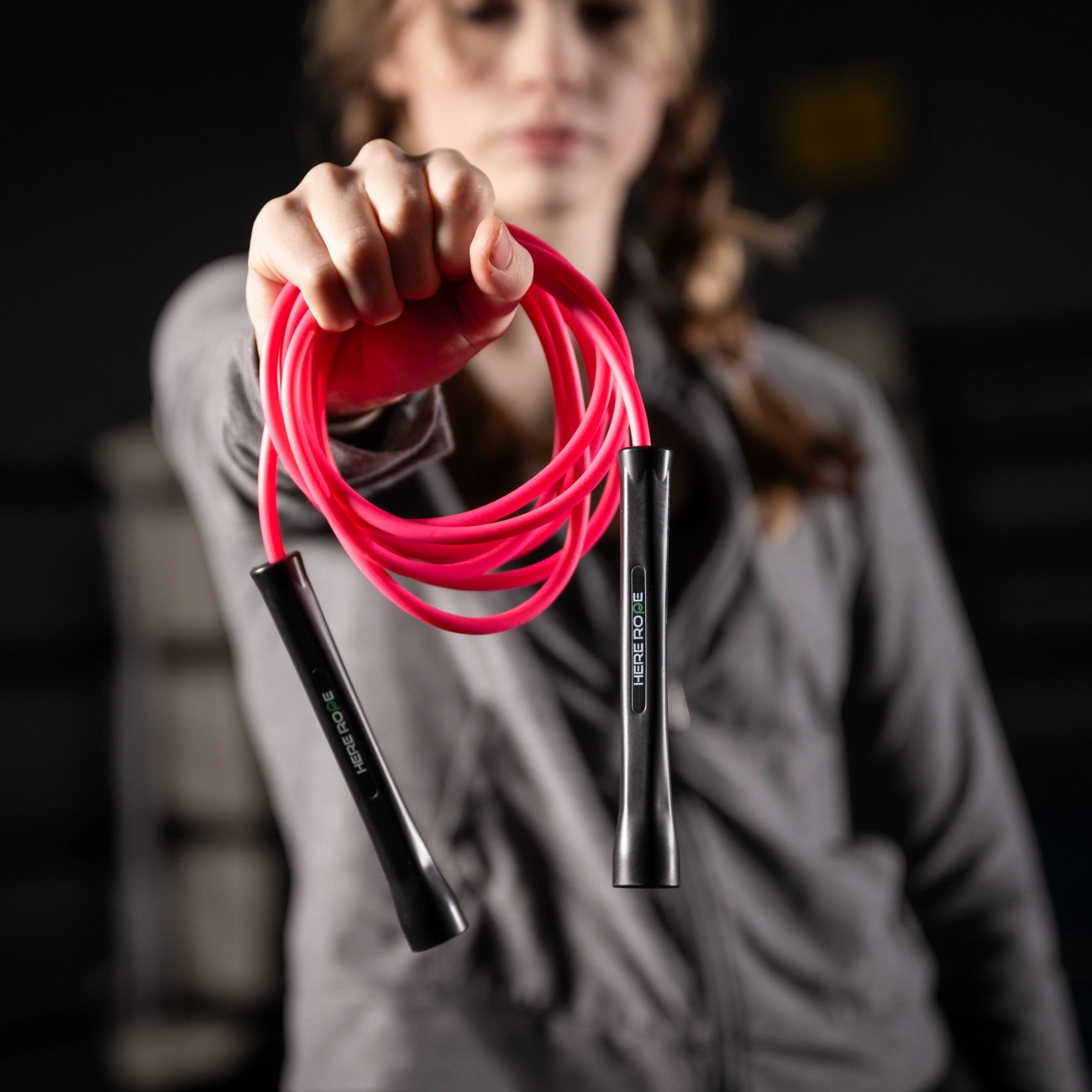Benefits of Rope Skipping Transformation
Rope skipping is one of the most effective, accessible, and enjoyable fitness activities you can incorporate into your daily routine. A 30-day rope skipping transformation plan can yield impressive results, impacting various aspects of your health and fitness. Here’s a closer look at the key benefits you’ll gain from regular jump rope workouts.
Cardiovascular Improvements and Fat Burning
Jump rope cardio workouts engage your entire body, making your heart work harder and improving cardiovascular health. This high-intensity exercise:
- Boosts heart rate quickly, enhancing endurance and stamina.
- Burns a significant number of calories in a short time, making it excellent for weight loss.
- Increases metabolic rate, helping you burn fat even after the workout ends.
Whether you follow a beginner rope skipping routine or advance to double unders training, the cardiovascular benefits remain a cornerstone of effective fat burning and heart health.
Improved Coordination and Agility
Regular rope skipping isn’t just about fitness; it sharpens your motor skills. The constant rhythm and timing required when jumping rope:
- Enhance hand-eye and foot coordination.
- Improve balance and agility, helping you move more fluidly in other sports or daily activities.
- Develop footwork precision, beneficial for athletes and anyone looking to boost overall body control.
This makes skipping rope an ideal exercise to build athleticism alongside endurance.
Bone Density and Muscle Toning Benefits
Contrary to some low-impact workouts, rope skipping provides a weight-bearing exercise that stresses bones just enough to promote increased bone density. This can reduce the risk of osteoporosis over time.
Additionally, the repeated jumping action tones and strengthens key muscle groups:
- Calves, quads, and hamstrings get a solid workout through landing and jumping.
- Core muscles engage to stabilize your body.
- Shoulders and arms develop strength and endurance from turning the rope.
Combined, these effects lead to leaner, more defined muscles and stronger bones.
Portable and Low-Cost Exercise Option
One of the greatest advantages of rope skipping is its convenience and affordability:
- You only need a good quality jump rope, like those available from JumpRopeWholesale, which offers durable and customizable options.
- You can skip rope virtually anywhere—indoors or outdoors—with minimal space.
- It’s a cost-effective alternative to gym memberships or bulky equipment.
This makes it perfect for busy lifestyles and for anyone wanting to start skipping rope daily without hassle.
Mental Health and Endurance Boost
Consistent jump rope training enhances mental focus and resilience. The rhythmic nature of skipping encourages a meditative state, reducing stress and improving mood. Plus:
- It builds mental endurance by challenging your concentration and determination during longer or more intense sessions.
- Supports the release of endorphins, often called “feel-good” hormones, improving overall well-being.
- Helps you develop discipline and persistence through a structured 30-day jump rope cardio workout plan.
By combining physical and mental benefits, rope skipping becomes a powerful tool for holistic health transformation.
By focusing on these benefits, you set yourself up for a successful and rewarding 30-day rope skipping transformation. The improvements in cardiovascular fitness, coordination, muscle tone, and mental health all contribute to a fitter, stronger, and more energized you.
What You Need Before Starting Your 30-Day Rope Skipping Transformation

Before you jump into a jump rope workout plan, it’s important to get your gear, space, and routine set up right. This makes your rope skipping routine for beginners safer, more effective, and enjoyable.
Choosing the Right Rope from JumpRopeWholesale
Picking the right jump rope is a big deal. At JumpRopeWholesale, you’ll find a range of options designed for all fitness levels:
- PVC Jump Ropes: Great for beginners and general fitness. They’re lightweight, durable, and easy to handle.
- Beaded Jump Ropes: Ideal if you want extra feedback with each jump; the beads make noise and add weight.
- Speed Ropes: Perfect for double unders training plans and advanced workouts focused on speed and endurance.
- Customizable Ropes: You can adjust length and handles for your height and grip preference.
Tip: Start with a rope that suits your current skill level. A rope too heavy or long can cause frustration. Measure your height and pick a rope size accordingly.
Proper Footwear and Clothing for Jump Rope Cardio Workouts
Jumping rope puts stress on your feet and joints, so wearing the right gear matters:
- Shoes: Go for supportive sneakers with good cushioning and grip. Cross-trainers or running shoes work well.
- Clothing: Wear lightweight, breathable workout clothes that allow full range of motion. Avoid baggy pants that might get caught in the rope.
- Socks: Choose moisture-wicking socks to keep your feet dry and reduce blisters.
Space and Safety Considerations for Rope Skipping
Jump rope is portable but needs a safe environment:
- Clear Area: Make sure you have at least 8 feet of ceiling height and 6 feet of clear space around you.
- Flooring: Use floors with some give, like wood or a gym mat. Avoid concrete or very hard surfaces to protect your joints.
- Surroundings: Remove any objects or furniture nearby that could trip you or cause injury.
Importance of Warm-Up and Cool-Down in Your Rope Skipping Routine
Skipping rope is high-intensity, so warming up and cooling down are key to prevent injuries:
- Warm-Up: Spend 5-10 minutes doing light cardio (walking, jogging) plus dynamic stretches like leg swings and arm circles. This prepares your muscles and joints.
- Cool-Down: After your session, slow down with gentle jogging or walking, followed by static stretches focusing on calves, hamstrings, and shoulders.
Skipping these steps increases risk of strains, so don’t skip the warm-up and cool-down if you want steady progress and injury prevention.
Getting the right gear and setting your environment up properly makes your 30-day fitness challenge jump rope journey smoother and more effective. With quality ropes from JumpRopeWholesale and the right prep, you’re set to transform your fitness safely.
Basic Rope Skipping Techniques for Beginners
Mastering the basics is key when starting your rope skipping routine for beginners or a jump rope workout plan. Here’s a straightforward guide to essential techniques, including some popular moves like the alternate foot step jump and introducing high knees and double unders training plan basics.
Basic Jump Form and Posture
- Stand tall with your feet shoulder-width apart.
- Keep your elbows close to your sides and turn the rope using your wrists, not your arms.
- Jump just high enough to clear the rope—about 1 to 2 inches off the ground.
- Land softly on the balls of your feet to reduce impact.
- Maintain a neutral spine and look straight ahead to keep balance.
Focusing on form reduces injury risk and ensures an effective jump rope cardio workout.
Alternate Foot Step Jump
This move mimics running in place while you jump rope.
- Instead of jumping with both feet, shift your weight from one foot to the other.
- Land softly on one foot while the other stays off the ground, then alternate quickly.
- This technique builds agility and coordination faster and ramps up your heart rate.
Alternate foot steps are a great way to mix up your routine while improving coordination with jump rope.
Introduction to High Knees and Double Unders
- High knees: Lift your knees up toward your chest each time you jump. It increases the intensity and engages your core.
- Double unders: The rope passes under your feet twice per jump. This move is challenging but excellent for boosting power and speed.
Start practicing double unders with short bursts, gradually building up as you gain more control and timing.
Common Mistakes and How to Avoid Them
- Jumping too high: Leads to unnecessary fatigue and foot strain. Keep jumps low and controlled.
- Using arms instead of wrists: Makes turning the rope harder and less efficient. Focus on wrist movement.
- Incorrect rope length: A rope that’s too long or too short can cause tripping. Make sure your rope length matches your height (check with a reliable guide or choose adjustable ropes).
- Landing flat-footed: This can hurt your knees and shins. Always land on the balls of your feet.
- Poor posture: Slouching or looking down throws off balance and breathing.
Correct these early to keep your skipping smooth, safe, and effective—critical tips for success in your 30-day fitness challenge jump rope.
Mastering these basics makes the rest of your 30-day plan easier and helps you get the most from every jump. Stick with good form, and the jump rope benefits for fat burning, cardio, and coordination will follow.
The 30-Day Plan for Rope Skipping Transformation

This plan is designed to help you progress steadily with a jump rope workout plan that builds endurance, coordination, and fat burn in just 30 days. Each week has clear goals, so you stay motivated and avoid burnout.
Week 1 Build the Foundation
Start by focusing on mastering basic jump rope techniques and proper form. Keep your sessions short and controlled to develop rhythm and prevent injury.
- Jump daily for 3-5 minutes total, broken into short intervals (30 seconds jump, 30 seconds rest).
- Prioritize smooth landing and steady pace.
- Use this week to get comfortable with the rope and your space.
Week 2 Increasing Endurance and Speed
Now that you’ve built a foundation, it’s time to gradually increase jump times and add variety with alternate foot steps.
- Push jump intervals to 45 seconds with 15 seconds rest.
- Incorporate alternate foot step jumps to improve agility.
- Try light interval training to boost cardio (e.g., 1 minute jumping, 30 seconds rest, repeat).
- Aim for sessions lasting 7-10 minutes total.
Week 3 Boosting Intensity
Start adding more challenging moves like double unders and high knees to your rope skipping routine for beginners.
- Mix in double unders (two rotations of the rope per jump) gradually.
- Add a circuit style workout combining jump rope with bodyweight exercises (push-ups, squats).
- Jump for 10-15 minutes broken into intervals, increasing speed and intensity.
- This week focuses on improving cardiovascular fitness and muscular endurance.
Week 4 Polishing Technique and Maximizing Fat Burn
Push your limits with longer and more varied sessions. This week is about refining skills and maximizing calorie burn.
- Include mixed jump styles: basic jumps, alternate foot steps, double unders, and high knees.
- Extend sessions to 15-20 minutes, including challenge days where you test endurance.
- Don’t forget recovery days with light jumping or stretching.
- Track your progress (time jumped, calories burned) and set goals for continued improvement.
By following this 30-day rope skipping plan, you’ll build a strong jump rope cardio workout habit that improves coordination, burns fat, and keeps you motivated. Remember, consistency is key to transformation.
Complementary Workouts and Nutrition Tips for Rope Skipping Transformation
To get the most out of your 30-day rope skipping transformation, supporting your jump rope workout plan with the right complementary exercises and nutrition is key. Here’s how to enhance your results safely and effectively.
Bodyweight Stretches and Strength Moves That Support Skipping
Building flexibility and strength can improve your skipping technique and reduce injury risk. Incorporate these simple moves:
- Dynamic stretches before skipping: leg swings, arm circles, hip openers to warm up muscles
- Static stretches after workouts: calves, hamstrings, quads, and shoulders to improve recovery
- Core strengthening exercises: planks, bicycle crunches, and Russian twists to boost balance and posture
- Lower body strength training: squats, lunges, and glute bridges help power your jumps and improve endurance
These moves support your coordination and agility improvements by reinforcing muscles you use while jumping rope.
Hydration and Nutrition Basics for Energy and Recovery
Energy supply and recovery fuel your daily skipping rope cardio workouts. Follow these nutrition basics:
- Stay hydrated: drink water before, during, and after your workout to maintain peak performance
- Eat balanced meals: combine lean proteins, complex carbs, and healthy fats to sustain energy levels
- Snack smart: grab a banana or nuts if you need a quick energy boost before jumping rope
- Post-workout recovery: choose protein-rich foods and hydration to help muscles repair and reduce soreness
Good nutrition helps with fat burning and endurance gains throughout your jump rope exercise routine.
Importance of Rest and Sleep
Rest days and quality sleep are just as important as your workout:
- Rest days: prevent overuse injuries by giving muscles time to rebuild; use active recovery like gentle walking or stretching
- Sleep well: aim for 7–9 hours to promote muscle repair, mental focus, and energy for your jump rope cardio workout
Proper rest ensures that your 30-day fitness challenge jump rope plan is sustainable and effective, reducing burnout and plateaus.
To learn more about effective jump rope techniques and routines, check out our detailed jump rope workout plans and customize your gear for the best experience with our customized skipping ropes.
Tracking Your Progress and Staying Motivated with Your 30-Day Rope Skipping Challenge
Staying consistent during your 30-day rope skipping transformation takes more than just jumping every day. Keeping track of your progress and finding ways to stay motivated is key to turning this into a lasting habit.
Use a Journal or App to Track Progress
- Record your jumps, duration, and calories burned after each session. This helps you see how far you’ve come and pushes you to improve.
- Apps like MyFitnessPal, Jump Rope Training, or simple note apps work well for logging your workout details.
- Tracking keeps you accountable and makes it easier to spot improvements in speed, endurance, and coordination.
Overcome Plateaus and Boredom
- Plateaus happen when your body adapts and progress slows. To break through, change your routine—try new jump rope techniques like double unders or alternate foot steps.
- Mix up your workouts by adding intervals or combining skipping with bodyweight exercises.
- Set small weekly goals to keep your focus sharp and celebrate your wins, no matter how small.
Use Community and Social Sharing for Motivation
- Join online groups or local rope skipping clubs to share your progress and challenges.
- Posting your achievements on social media can provide encouragement and friendly competition.
- Engaging with others makes your jump rope cardio workout more fun and holds you accountable.
Staying motivated and tracking your progress are just as important as the jumps themselves. With clear goals, varied routines, and a supportive community, you’ll smash your 30-day fitness challenge jump rope goals and build a lasting skipping habit.
Why Choose JumpRopeWholesale for Your 30-Day Plan for Rope Skipping Transformation

When starting a 30-day fitness challenge jump rope routine, the right equipment makes all the difference. At JumpRopeWholesale, we focus on quality and durability, delivering ropes that stand up to daily use and intense workouts.
Premium Quality and Durable Jump Ropes
Our ropes are built to last. Whether you choose PVC jump ropes, beaded skipping ropes, or heavy skipping ropes, each product is crafted with materials designed to resist wear and tear through countless sessions. This means you get consistent performance and a smooth jump rope cardio workout every time, critical for staying motivated in your 30-day plan.
Customer Testimonials Prove Our Reliability
We don’t just claim quality — our customers in the United States consistently praise the long-lasting nature and feel of our ropes. Many have reported improvements in their fitness journey using our ropes daily, confirming that our products support real progress in rope skipping for weight loss, endurance, and coordination.
Rope Customization Options to Match Your Needs
Every jumper is unique. That’s why our site offers rope customization, allowing you to select lengths, handle types, and colors for a personalized experience. Choosing the best jump ropes for fitness means picking one that fits your height and style, making skipping more comfortable and efficient from day one. Find out more on how to customize your skipping rope for the perfect fit.
Bulk Ordering and Cost Benefits for Serious Jumpers and Gyms
If you’re a trainer, gym owner, or just committed to your rope skipping routine, bulk ordering options provide excellent value. Stocking up on quality ropes lowers your cost per unit, letting you equip your whole workout space or share with your fitness group. This makes your jump rope workout plan affordable and sustainable long-term.
Choosing JumpRopeWholesale means investing in a trusted skipping rope manufacturer who understands the demands of your fitness goals. Our durable, customizable, and cost-effective ropes are designed to help you cross every hurdle in your 30-day plan for rope skipping transformation successfully.
Explore more on finding the right ropes and maximize every jump: customize skipping rope and heavy skipping rope.
Safety Precautions and Injury Prevention for Rope Skipping Routine
When starting a jump rope workout plan, staying safe and injury-free is just as important as your performance. Here’s what you need to know to protect yourself during your 30-day fitness challenge jump rope.
Recognizing Signs of Overuse Injuries
Overdoing it with rope skipping, especially when increasing duration or intensity, can lead to overuse injuries. Watch for:
- Persistent pain or soreness in the shins, knees, or ankles
- Swelling or tenderness around joints or muscles
- Reduced range of motion or stiffness the day after workouts
- Numbness or tingling in feet or lower legs
Ignoring these signs can worsen injuries. If you notice them, reduce your skipping time or take a few rest days.
Proper Warm-Up and Cool-Down Routines
A proper warm-up prepares your muscles and joints, reducing injury risk. For rope skipping, spend 5-10 minutes on:
- Light jogging or marching in place
- Dynamic stretches like leg swings, arm circles, and ankle rolls
- Basic jump rope moves at a slow pace to get your body ready
After your session, cool down with 5-10 minutes of:
- Slow jumping or walking to lower heart rate
- Static stretches targeting calves, hamstrings, quads, and shoulders
This helps reduce muscle tightness and speeds recovery, essential for maintaining an effective rope skipping routine for beginners and pros alike.
When to Seek Professional Advice
If pain persists beyond a few days or worsens despite rest and self-care, it’s time to talk to a healthcare professional. Specifically:
- Sharp or sudden pain during skipping
- Swelling that doesn’t improve or worsens
- Loss of strength or mobility in your legs or feet
- Signs of stress fractures or tendonitis
Working with a physical therapist knowledgeable about jump rope cardio workouts can help identify issues, adjust your technique, and recommend rehab exercises.
By recognizing injury signs early, warming up and cooling down properly, and seeking help when needed, you’ll protect your body throughout the 30-Day Plan for Rope Skipping Transformation. This approach keeps you on track to enjoy all the benefits of jump rope exercise while minimizing setbacks.



